|
|
|
|
News |
Ultrafast Laser Laboratory Department of Electronic and Electrical Engineering |
|
March 2018 Sub-surface modes in plasmonic THz resonators are revealed by THz near-field spectroscopy We show that double-metal resonators can be investigated experimentally by THz near-field probes. This demonstration opens doors for investigations of strong light-matter coupling and novel THz resonator designs, and expands the application spectrum of THz near-field imaging and spectroscopy. The double-metal THz plasmonic resonators are at the forefront of research on THz optoelectronic devices, such as THz detectors, metasurfaces and fast modulators, because the double-metal design allows achieving strongly confined THz fields and thus enhancing light-matter interaction with nanoscale systems. However experimental investigations of light-matter interaction in such resonators has been challenging because the resonator size is typically ~1/10th of the wavelength, and the modes of interest are distributed below the surface. THz near-field spectroscopy offers a solution to this challenge. Using the aperture-type THz near-field probes developed in our group, we investigated two resonator geometries: a lambda/2 double-metal patch antenna with a 2 micrometre thick dielectric spacer, and a three-dimensional meta-atom resonator. We observed that the resonators couple a small fraction of their energy to the resonator surface via surface waves. THz time-domain spectroscopy analysis of the fields at the resonator surface displayed spectral signatures corresponding to the sub-surface modes. Investigations of strong light-matter coupling in resonators with sub-surface modes therefore can be assisted by aperture-type near-field probe THz spectroscopy. Furthermore, near-field interaction of the probe with the resonator enables tuning of the resonance frequency for the spacer mode in the antenna geometry from 1.6 to 1.9 THz (~15%). Graphics: Experimental map of two modes supported by a double-metal dipole antenna |
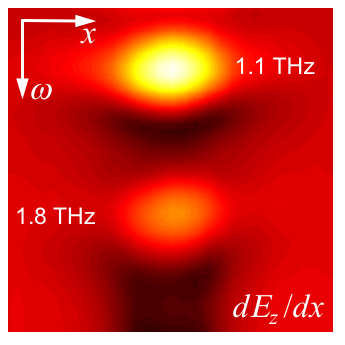 |
|
|
Feb 2018 Photoconductive terahertz detectors are made more efficient by nano-structuring the photoconductive channel We developed photoconductive terahertz detectors, which incorporate all-dielectric optical metasurfaces. The metasurface opens possibilities for tailoring optical and electronic properties of the photoconductive channel, and overcoming intrinsic materials limitations. This research promises highly-efficient and sensitive nano-scale THz detectors for THz spectroscopy and imaging applications. The photoconductive detectors with metasurfaces described in the article published in APL Photonics showed improved efficiency in comparison to conventional detectors with similar dimensions of the photoconductive channel. The nanostructured channel consists of nanobeams etched in a thin layer of low-temperature (LT) grown GaAs, and a distributed Bragg reflector underneath. This metasurface is designed to support a confined mode, as our numerical modelling and experimental results confirmed. The structure efficiently absorbs ultrafast optical excitation, and owing to the sub-picosecond carrier lifetime in LT GaAs, it can be quickly switched between the conductive and resistive states. Graphics: SEM micrographs of the nano-structured photoconductive channel |
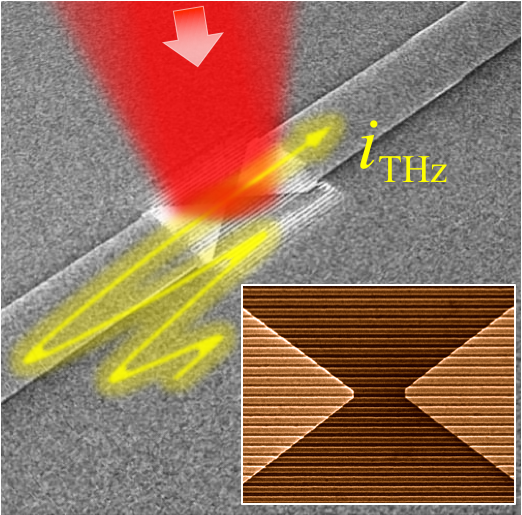 |
|
|
Nov 2017 Solid indium resonant scattering tips improve sensitivity in THz microscopy applications We developed new near-field scattering tips for THz microscopy applications. Scattering type near-field microscopy recently enabled imaging at THz frequencies with spatial resolution of ~20nm. This technique however requires near-field probes, which scatter THz waves efficiently. In this research, we demonstrate solid Indium tips with the scattering efficiency enhanced by the dipolar resonance supported by the indium cone. We evaluated the scattering properties of resonant Indium cones experimentally using THz time-domain spectroscopy, and numerically using the finite-difference time-domain method. In order to enable practical THz microscopy applications of these resonant probes, we demonstrated a simple excitation scheme utilizing a THz source, which excites a radial mode guided along the length of the Indium shaft to the tip apex. Graphics: Artistic illustration of the near-field probe with the resonant scattering In tip |
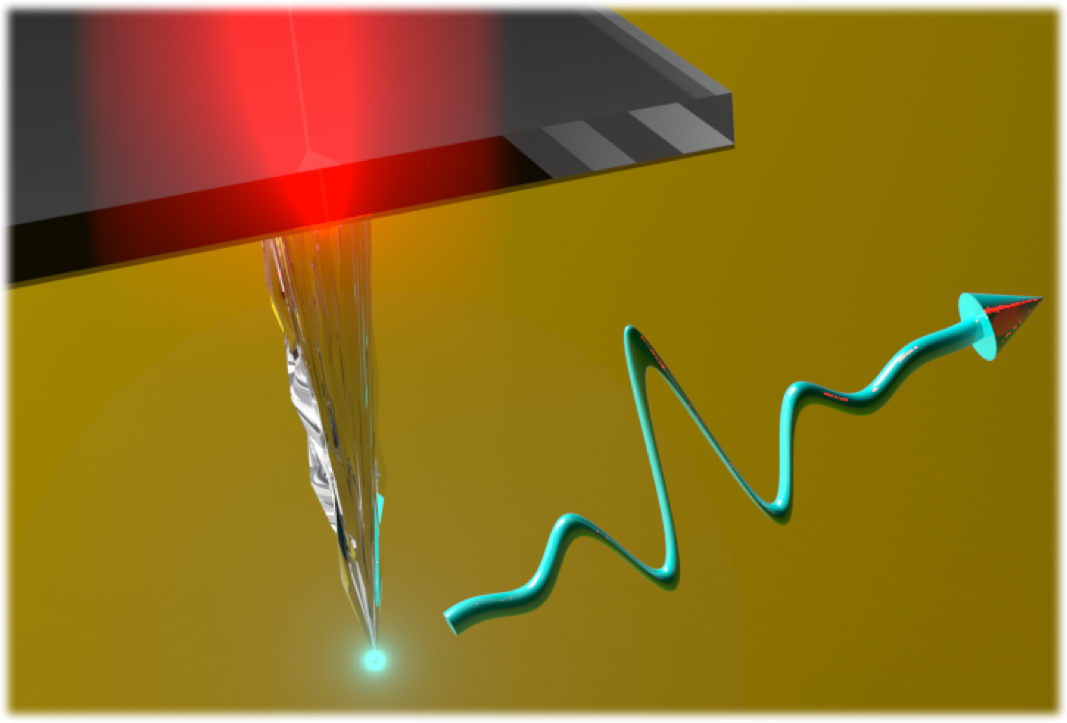 |
|
|
Aug 2017 THz Near-field Microscopy: Science, Technology and Insights Plenary presentation at the 42nd International Conference on Infrared, Millimeter and Terahertz Waves (IRMMW-THz 2017) in Cancun, Mexico The presentation is available at UCL Discovery: PDF |
||
|
March 2017 A novel THz near-field microscopy probe exploits an embedded semiconductor nanowire for sensitive detection of THz fields Light transmission through a sub-wavelength size aperture is fundamentally limited by the wave nature of light. It prevents applications of aperture-type microscopy in the deeply sub-wavelength regime. In this work, published in Scientific Reports, we propose and demonstrate a novel near-field probe architecture that exploits inherently strong evanescent THz fields arising within the aperture to mitigate the problem of vanishing transmission. We integrated a semiconductor nanowire within a specially designed aperture of the probe. In this geometry, the nanowire act as a sensitive THz detector. We used this probe for mapping the profile of a focused THz beam from a quantum cascade laser. This research leads to a new sub-wavelength resolution THz imaging approach which can be used with THz quantum cascade lasers, compact solid-state sources already covering a large portion of the THz spectral range. Such a simple and compact THz coherent imaging system could provide THz near-field imaging and spectroscopy capabilities to a broader range of scientific and engineering applications. Graphics: Aperture of the near-field probe with an embedded nanowire acting as THz detector (top left). Maps of the THz beam profile in the xy-plane (bottom left), zy-plane (bottom centre), and line-scan through the beam centre (right) |
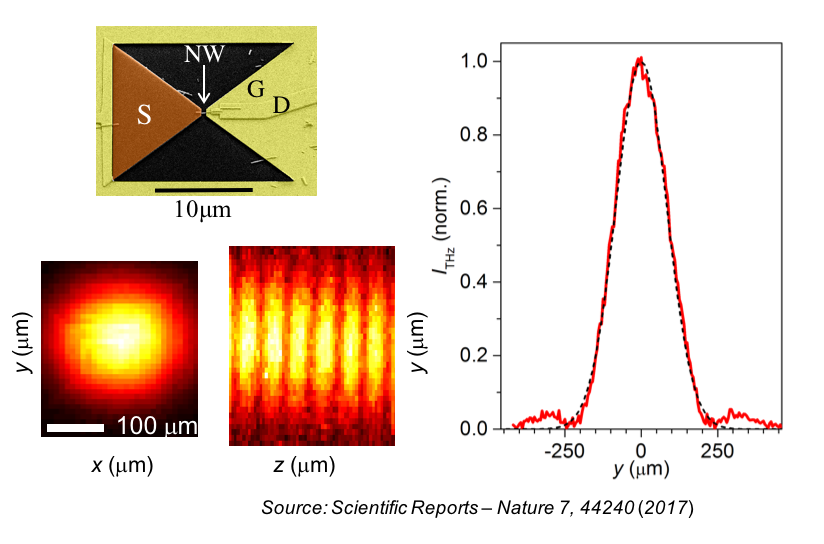 |
|
|
Feb 2017 Hybrid cavities with plasmonic nanoantennas enable optically thin THz photoconductive detectors We developed a hybrid optical cavity consisting of a nano-antenna array and a distributed Bragg reflector (DBR) in order to realise optically thin THz photoconductive detectors. The optically thin cavities will enable miniaturisation and integration of THz opto-electronic detectors and emitters. The hybrid cavity captures and traps incident light at the selected wavelength and photo-excites the active region of the THz detector. When illuminated by a short (100 fs) optical pulse, the THz detector activates and senses the electric field of THz waves. The THz detectors will be integrated into THz near-field scanning microscopy probes. The developed hybrid cavity consists of a nano-antenna array and a DBR (see Graphics). The cavity can be made very thin (~100 nm). The cavity shows characteristic absorption bands defined by the PC layer thickness and the DBR design enabling operation at selected wavelengths Article in Applied Physics Letters Graphics: Schematic of the hybrid cavity and the optical absorption spectrum showing the cavity modes |
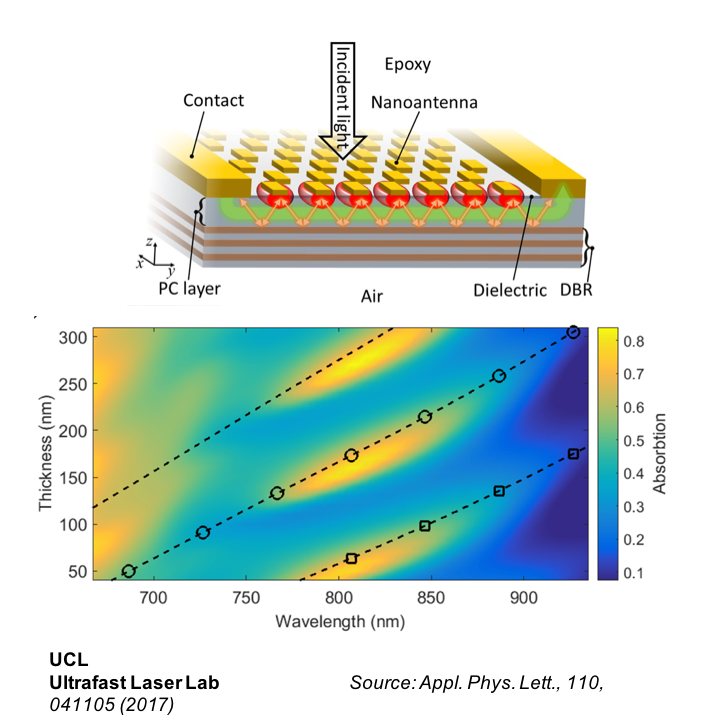 |
|
|
Feb 2017 OPTICAL TERAHERTZ SCIENCE AND TECHNOLOGY Conference Conference program: here The seventh international conference on Optical Terahertz Science and Technology (OTST 2017) will bring researchers from around the world to present and discuss most recent advances in terahertz (THz) research, ranging from fundamental science to cutting edge developments in THz technology. For the first time the conference will be held in Europe in the heart of London following the previous six conferences held in USA and Japan. Conference chairs: Dr Oleg Mitrofanov and Dr Miriam Serena Vitiello Conference dates: Apr 2-7, 2017 |
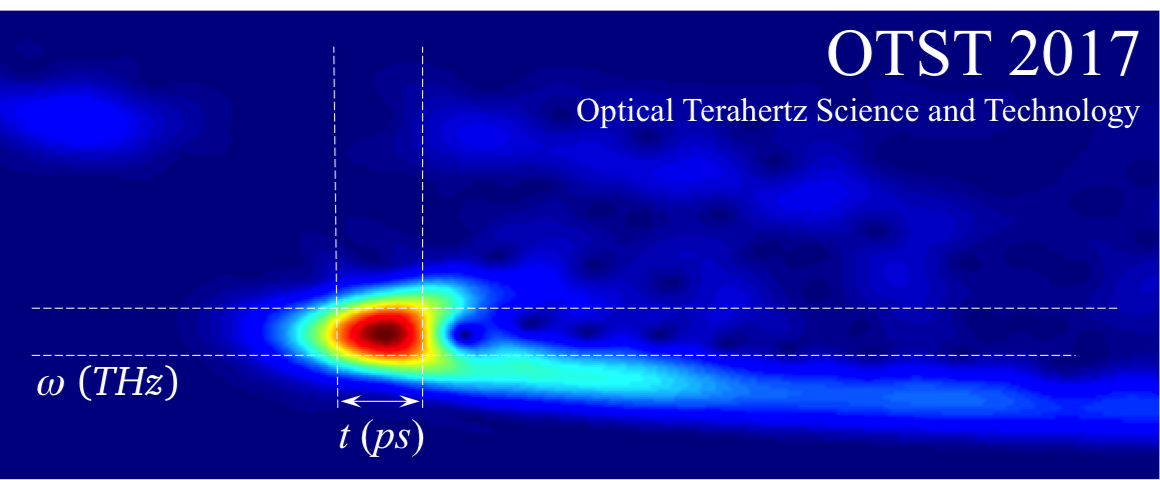 |
|
|
Feb 2017 Internal fields inside double-metal resonators are detected using THz near-field spectroscopy We demonstrated that THz fields confined within a closed double-metal resonator on the subwavelength scale can be detected using the concept of image charges and the near-field microscopy technique developed at UCL. This demonstration opens doors to studies of light-matter interaction in deeply sub-wavelength volumes at THz frequencies. Illumination of the resonator by a broadband THz pulse at normal incidence leads to excitation of two lowest order modes (see Graphics). The THz field detected by an aperture-type near-field probe (see Graphics) represents the normal component of the Electric field inside the double-metal resonator. Article in Applied Physics Letters Graphics: Map and spectrum of the THz field detected within a double-metal resonator |
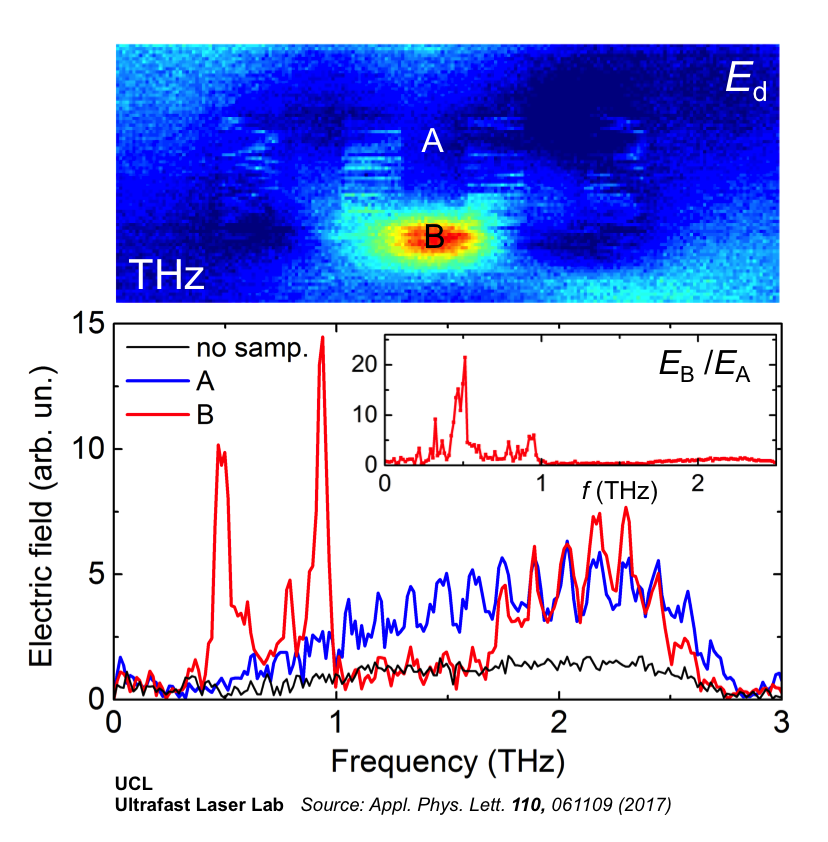 |
|
|
Dec 2016 Effect of THz pulse generation by radial transient photo-currents enables launching of broadband THz pulses into coaxial waveguides Coaxial waveguides are commonly used for transmission of high-frequency electronic signals, up to the GHz range, because they exhibit minimal or no dispersion, preserving integrity of the signal. Coaxial waveguides are also attractive for transmission of broadband THz pulses, however practical implementations encounter a range of technical problems, including the coupling of THz pulses into the waveguides, which we addressed in this research. We investigated launching of THz pulses into coaxial waveguides using the effect of THz pulse generation at semiconductor surfaces. We found that the radial transient photo-currents produced upon optical excitation of semiconductors radiate THz pulses with the field distribution naturally matching the TEM mode of the coaxial waveguide. We demonstrate a simple scheme (illustrated in the diagram), where the optical excitation beam of an InAs plate produces a radially-polarised THz wave, which couples into the hollow coaxial THz waveguide. The spatial profile and the polarisation state of the THz pulse can be tailored by the spatial profile of the optical excitation. In our case, the diameter of the optical beam allows us to optimise the spatial profile of the generated THz pulse for efficient waveguide coupling. Graphics: Illustration of THz pulse generation directly into the coaxial waveguide mode |
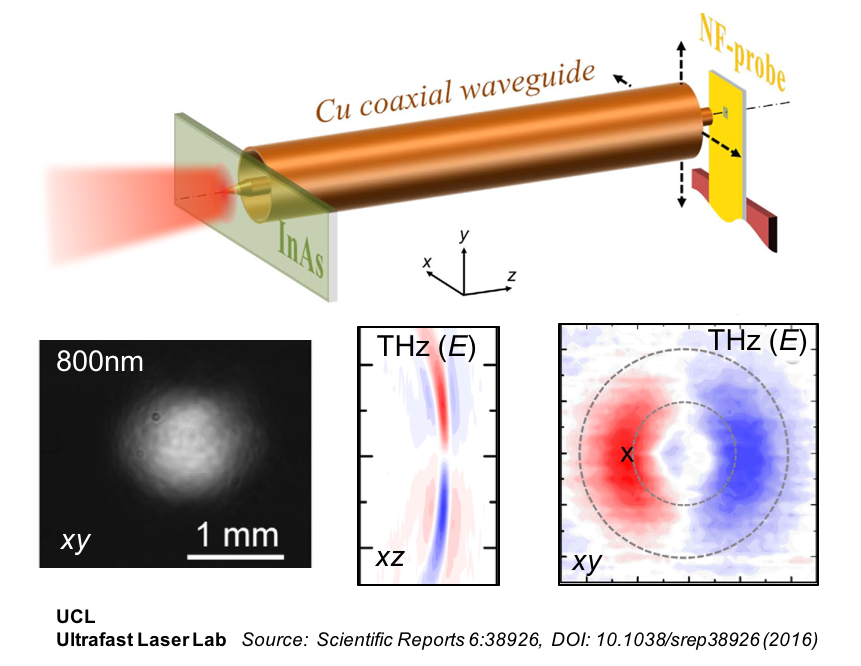 |
|
|
July 2016 Splitting of the fundamental magnetic dipole resonance in crystalline TiO2 micro-spheres shows the potential for all-dielectric THz metamaterials For the first time THz magnetic dipole resonances in crystalline titanium dioxide (TiO2) micro-spheres are characterised without linewidth broadening caused inhomogeneities. Strong material anisotropy splits the magnetic dipole resonance in TiO2 micro-spheres at THz frequencies . Two non-degenerate resonances, with linewidths as narrow as 10 GHz, appear in near-field spectra measured for individual micro-spheres using aperture-type near-field THz time-domain spectroscopy. The narrow linewidth, unobstructed by inhomogeneities, show the potential of crystalline TiO2 as a material for all-dielectric THz metamaterials. The measurement technique enables precise characterization of TiO2 properties in sub-wavelength size micro-spheres. The back cover picture in Laser & Photonics Reviews (July 2016) illustrates the excitation of two non-degenerate orthogonal magnetic dipole modes in a micro-sphere illuminated be a linearly-polarised broadband THz pulse. These modes are represented as ripples of the scattered resonant waves. The blue and red colours represent the difference in the resonance frequency of the two excited modes. The crystalline TiO2 micro-sphere at the image centre is ~20 micrometres in diameter. Article in Laser and Photonics Reviews Graphics: Illustration of the magnetic dipole splitting (Laser & Photonics Reviews, back cover). |
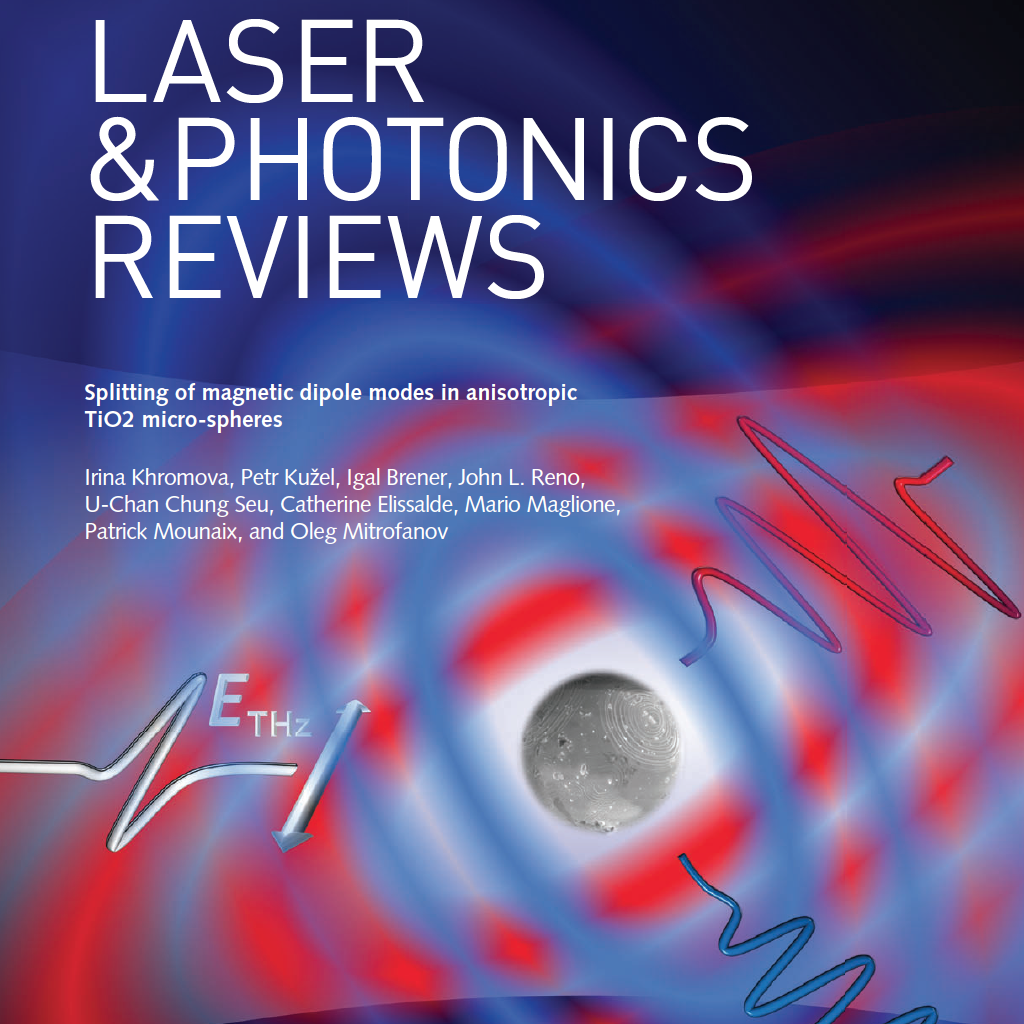 |
|
|
May 2016 Excitation of plasmonic resonances in conductive fibres is visualised using THz near-field microscopy Resonant plasmonic excitations lead to fascinating optical effects, including the brilliant colours of stained glass decorating medieval cathedrals. To shed light on the process of plasmonic resonance excitation, we experimentally mapped the evolution of the electromagnetic field near a conductive fibre, from the moment of initial polarisation of the fibre to the formation of a standing wave along the fibre and to the resonance dissipation. To detect this process experimentally we used a scanning near-field microscopy technique at THz frequencies and a conductive fibre illuminated by a single cycle THz pulse. By sampling the field near the fibre in space and time, this technique allows us to visualise the formation of the standing wave along fibre as the incident pulse polarises it. The technique also allows us to perform local spectroscopic analysis at one of the standing wave crests, which shows the spectral signature of the resonance. These finding demonstrate the potential of near-field analysis methods for mode mapping and local spectroscopy of plasmonic THz resonators. Details of this study are published in a Special Issue on THz near-field microscopy in the IEEE Transactions on Terahertz Science and Technology. Article in IEEE Transactions on Terahertz Science and Technology Graphics: Schematic representation of the plasmonic resonance in a carbon fiber and a near-field map of the standing wave. |
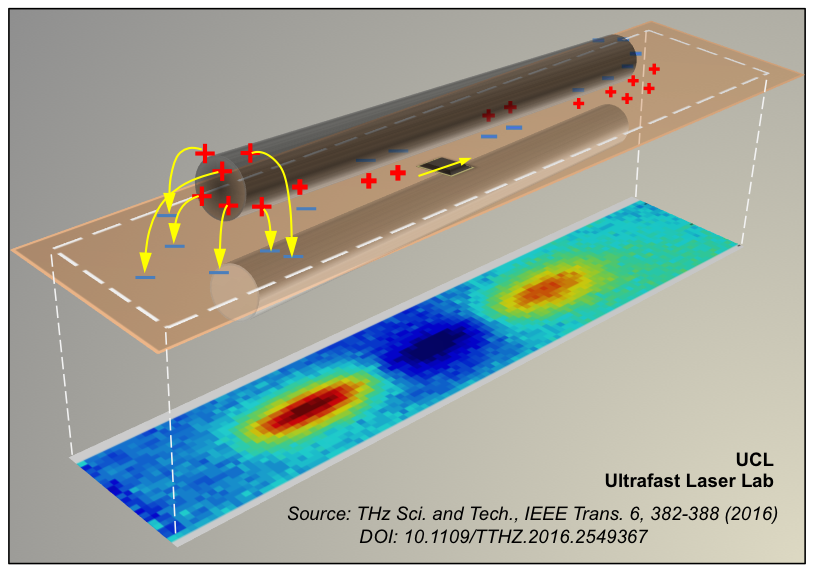 |
|
|
March 2016 The self-mixing effect in quantum cascade lasers (QCLs) is utilised for sub-wavelength resolution THz imaging In collaboration with the THz research group at the University of Leeds, we demonstrated THz microscopy with sub-wavelength spatial resolution using the self-mixing effect.
Article in Applied Physics Letters Graphics: THz QCL self-mixing near-field image (a) and an AFM image of the same area showing a corner of a metallic square on a dielectric substrate |
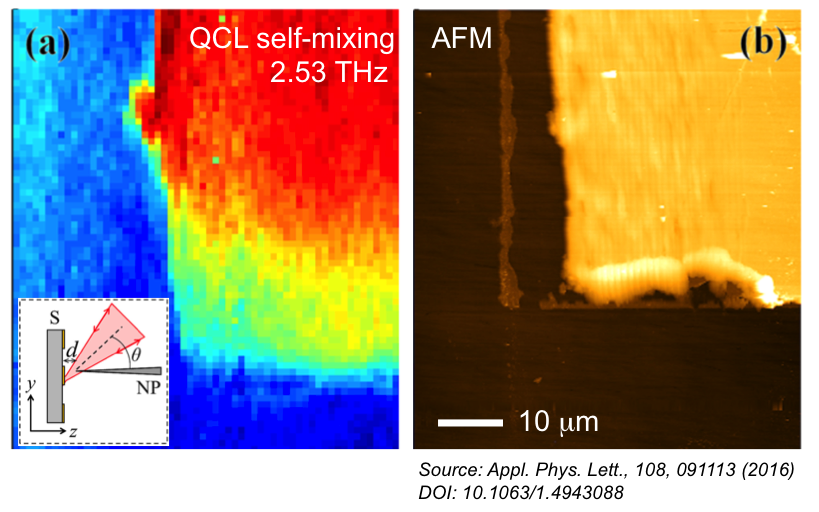 |
|
|
February 2016 Split shell design suppresses the cutoff effect in conical metallic waveguides In collaboration with the University of Utah, we demonstrated focusing of terahertz (THz) waves to subwavelength diameter beams using a split conical waveguide. Such waveguide can be used for practical imaging using THz waves with spatial resolution better than the diffraction limit. Conical waveguides can focus electromagnetic waves, however not for all frequencies. To mitigate this problem, known as the cutoff effect, we designed and investigated a conical tapered waveguide, which consist of two pieces, such that there is an adjustable gap along the waveguide length. Thin sidewalls in the vicinity of the gap prevent energy leakage through the gaps. Such a waveguide focuses THz waves within a wider spectrum without compromising the mode confinement. We experimentally confirmed the focusing properties using our THz near-field imaging system: an incident THz wave is focused to a spot smaller than 100 micrometers (see Graphics). These conical waveguide can be used instead of a lens in THz imaging systems to achieve spatial resolution better than the diffraction limit.
Graphics: Schematic diagram of the split conical waveguide and the output field profile |
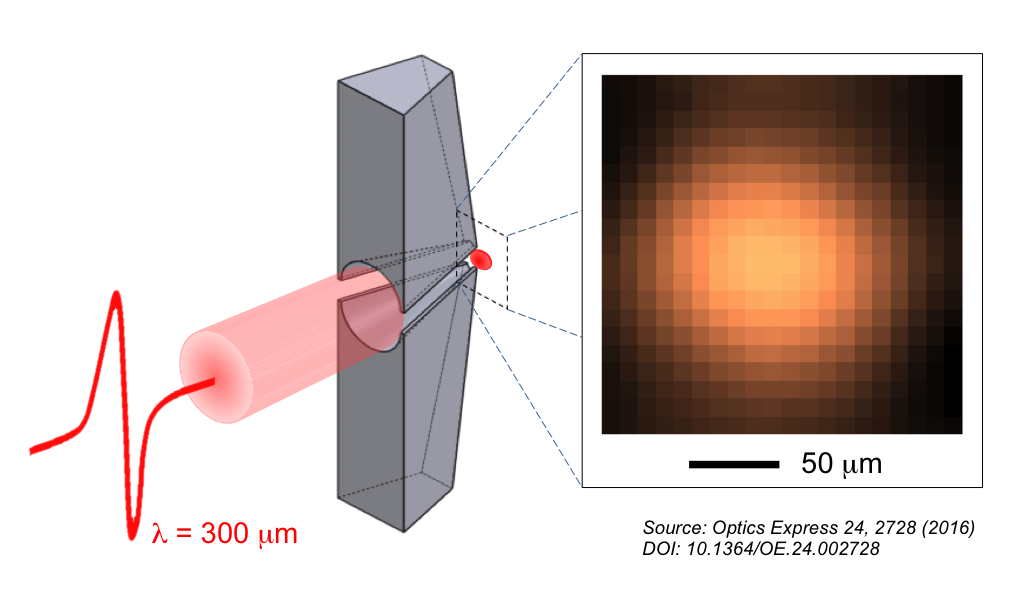 |
|
|
November 2015 Photonic nano-structures enhance sensitivity and spatial resolution in terahertz microscopy We demonstrated optoelectronic terahertz near-field probes, which enhance spatial resolution and sensitivity of terahertz microscopy. Applications of these near-field probes will enable further scientific investigations of terahertz phenomena. To advance resolution capabilities of terahertz near-field scanning probe microscopy, we developed a nano-structured terahertz detector and integrated it into the near-field microscopy probe. The detector structure contains an array of optical nano-antennas and a distributed Bragg reflector. When illuminated by a short optical pulse, this structure traps optical photons and activates a small terahertz detector, which allows sampling terahertz waves on the scale over 100 times smaller than the terahertz wavelength.
Graphics: Schematic diagram of the near-field probe with embedded nano-antennas |
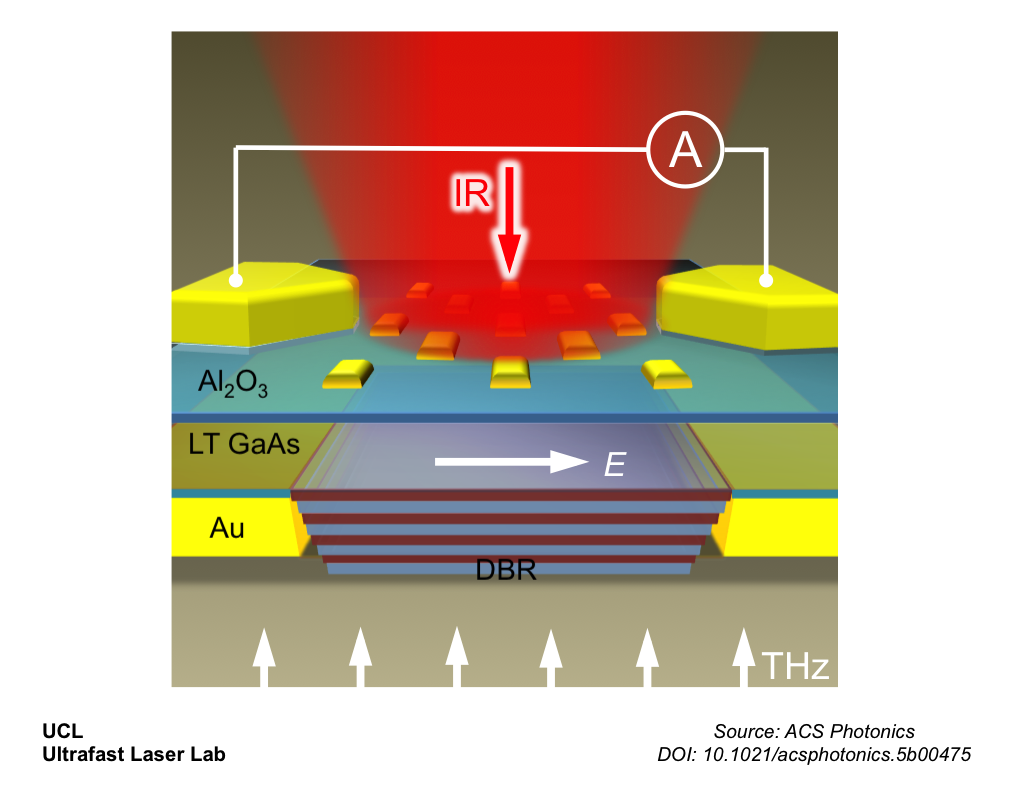 |
|
|
October 2015 Efficient coupling of double-metal THz QCL to low-loss flexible waveguides In collaboration with the University of Cambridge and Rutgers University (USA), we developed a scheme for efficient coupling of emission from THz lasers into flexible THz waveguides. Efficient coupling and guiding of THz waves is a critical step in bringing applications of THz technology to life. A promising source of coherent THz waves is a semiconductor THz laser, which produces THz emission as a result of quantum jumps experienced by electrons cascading down a specially engineered structure. The quantum cascade lasers however typically produce poor quality THz beams. In this work we designed and demonstrated a system of THz waveguides, which enables delivering THz radiation with minimal losses as well as producing low-divergence free-space propagating THz beams, key for THz imaging applications. In this system, a strongly diverging emission from a 2.85 THz double-metal quantum cascade laser is shaped and coupled into a dielectric-lined hollow metallic waveguide, made from a flexible 1 mm diameter glass tube. This waveguide is among the best THz guides demonstrated to date. The transmission loss as low as 5 dB/m.
Graphics: Coupling of THz QCL to low-loss flexible waveguides |
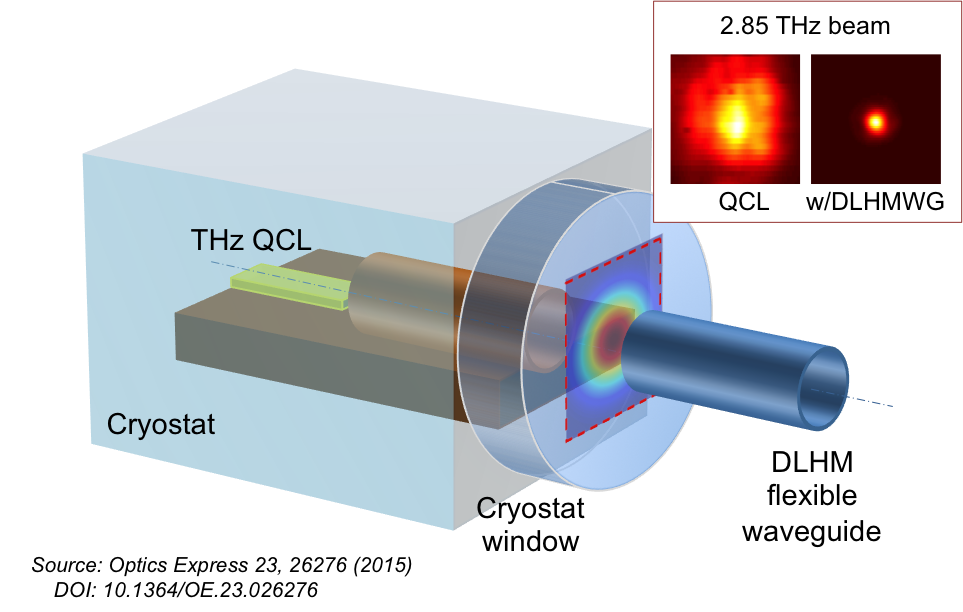 |
|
|
September 2015 Terahertz surface waves on graphene We observed THz surface plasmon waves on graphene structures using THz near-field microscopy with a sub-wavelength aperture probe. Graphene plasmons, the collective oscillations of Dirac fermions, can provide unique functionalities in opto-electronic devices. In the infra-red part of the electromagnetic spectrum, surface plasmons have been observed in graphene nanostructures with the surface plasmon wavelength more than 100 times smaller than the wavelength of incident light. At THz frequencies however, the wavelength mismatch reduces making the phenomenon of graphene surface plasmons elusive. In this work we investigated THz surface waves on lithographically-defined graphene structures, e.g. bow-ties and ribbon arrays, using the THz time-domain spectroscopy technique. THz near-field images reveal that similar to metals, multilayer and single layer graphene on SiC support excitation and propagation of THz surface waves. Article in Solid State Communications Graphics: Excitation of a THz standing wave on a graphene bowtie antenna |
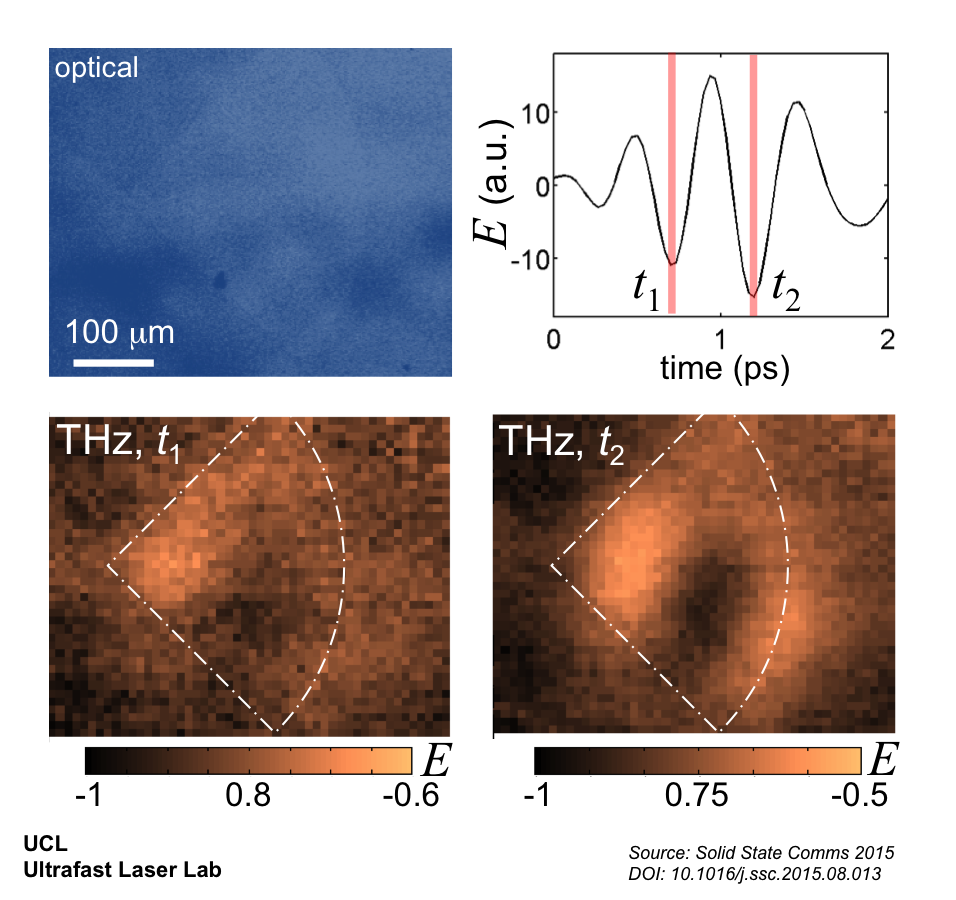 |
|
|
July 2015 Terahertz plasmons in carbon fibers Plasmonic resonances in carbon micro-fibers are observed with our THz near-field spectroscopy and imaging technique. This method can be used for non-contact probing of THz conductivity in sub-wavelength size single particles. |
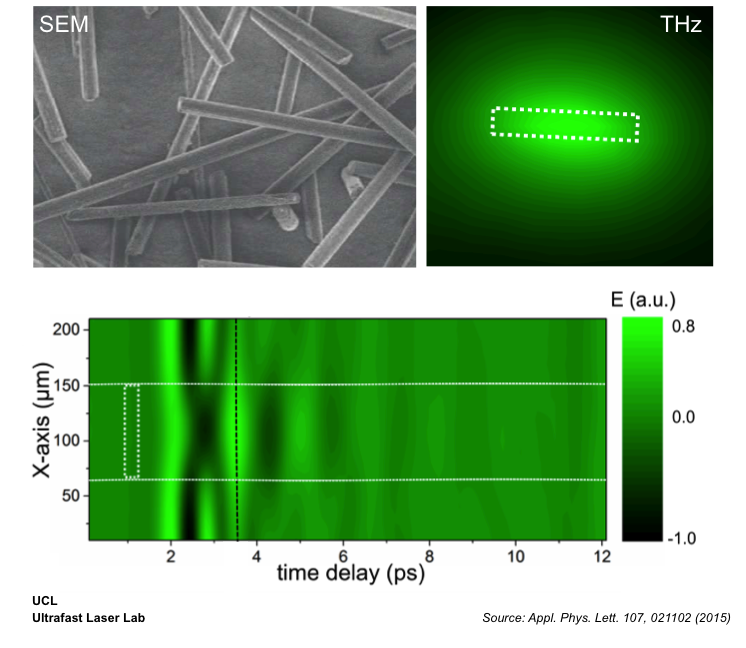 |
|
|
May 04, 2015 Terahertz waveguides made of teflon tubing coated with silver We show that thin teflon tubes coated with silver guide THz waves in the hybrid HE11 mode and suppress other waveguide modes. The mode-cleaning effect allows achieving single-mode propagation in multimode waveguides. The concept of dielectric-lined hollow metallic waveguides is one of the most promising for THz waves. It enables guiding THz waves with relatively low losses. The dielectric-lined waveguides however support several modes of propagation, which can cause problems in analysing transmitted signals. In this work we demonstrate that using teflon as the dielectric mitigates the multi-mode behaviour. Article in Journal of Infrared, Millimeter, and Terahertz Waves |
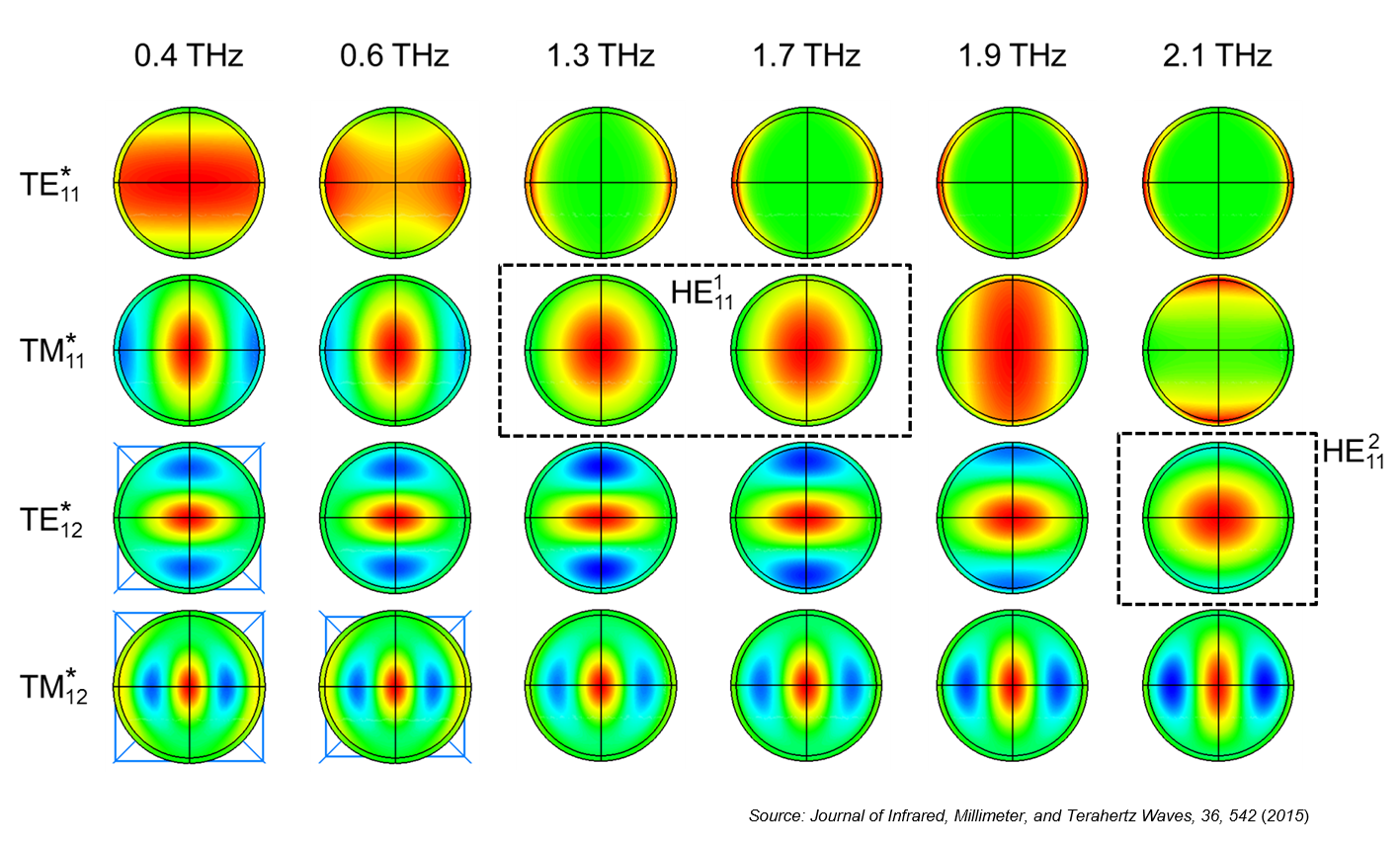 |
|
|
Mar 05, 2015 Near-field mapping of photocurrents that emit THz pulses We reveal the key role of in-plane photo-excited charge density gradients in the process of THz pulse generation using THz near-field microscopy. Near-field maps of the generated THz wave recorded for the first time showed that the radiation originates primarily from the regions where the in-plane gradient of the photocarrier concentration is highest, questioning the widely accepted understanding of the THz pulse generation effect. The process of generation of THz pulses following photo-excitation of semiconductors is one of the most widely used effects for producing coherent THz radiation. It has been attributed to transient photo-currents in the direction normal to the semiconductor surface, while the carrier dynamics within the surface plane had been considered negligible until recently. THz near-field microscopy allowed us to shed light on the mechanism of this effect. The observations suggest that ambipolar expansion of the electron-hole gas within the surface causes a major contribution to the radiated field. |
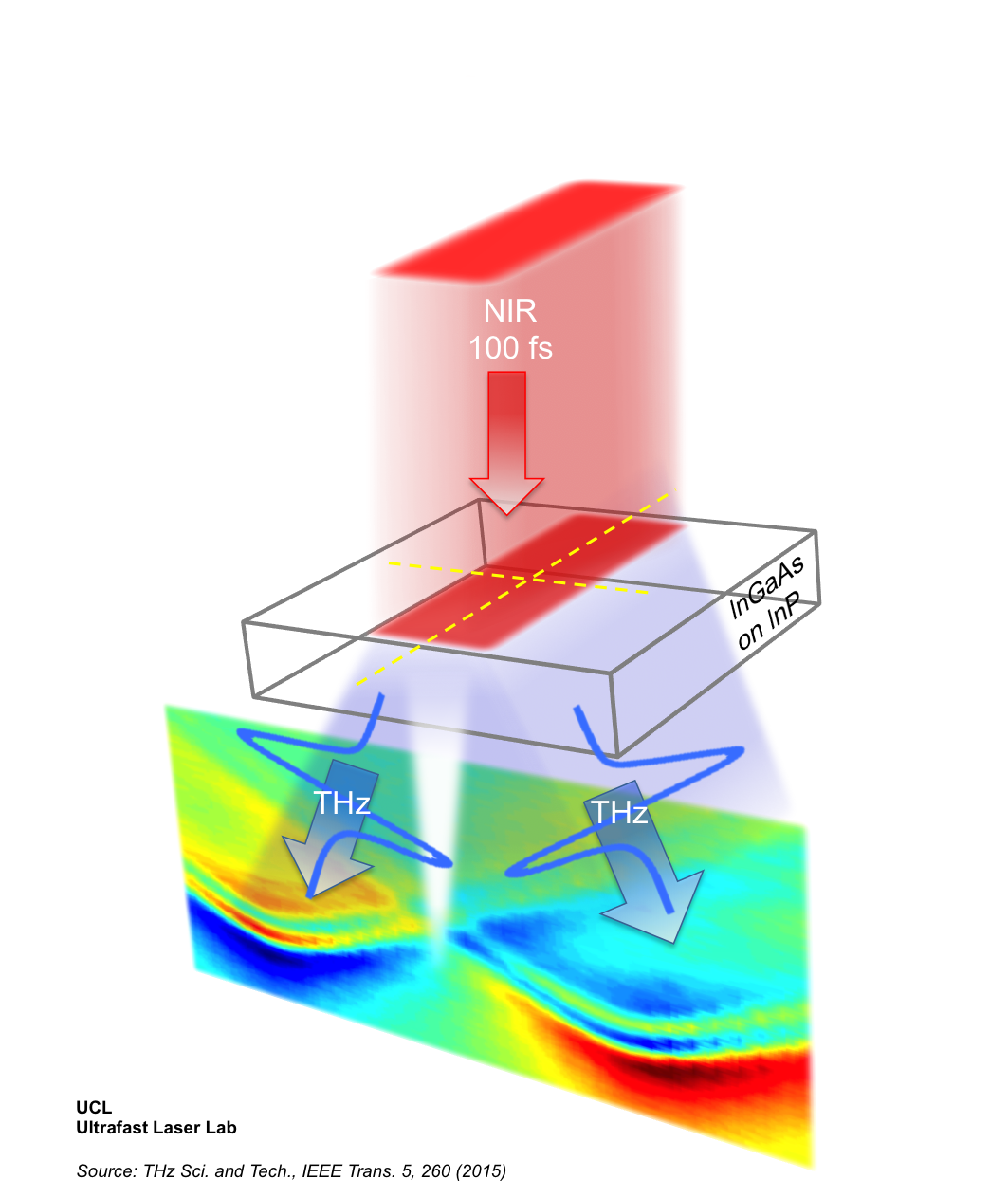 |
|
|
Sep 17, 2014 Terahertz Mie resonances in sub-wavelength size dielectric spheres We demonstrate that THz resonances in a dielectric particle can be detected and characterised using the effect of enhanced transmission through a sub-wavelength size aperture. This approach enables investigations of fundamental properties of single dielectric resonators required for engineering artificial materials, called metamaterials, with an unusual electromagnetic response to THz waves. The concept of metamaterials permits realising optical phenomena, which are not found in ordinary materials, such as the negative refraction and cloaking. The key requirement for these effects is negative magnetic permeability. While the magnetic response of ordinary materials disappears at high frequencies, an effective magnetic response can be engineered using high-permittivity dielectric spheres or split-ring resonators. In a dielectric sphere, the lowest frequency resonance, or the 1st Mie resonance, produces the required effective magnetic response. Characterisation of individual resonators at THz frequencies however is highly challenging. We applied near-field THz spectroscopy for the first time to probe the Mie resonances in high-permittivity TiO2 micro-spheres and found that this method provides detailed properties of the resonator modes. The observed properties of the 1st Mie resonance in TiO2 microspheres showed that dielectric THz metamaterials can be realised. The characterisation method also allows us to map of the electric field distribution near the resonator providing further insight into its function as a building block for metamaterials. |
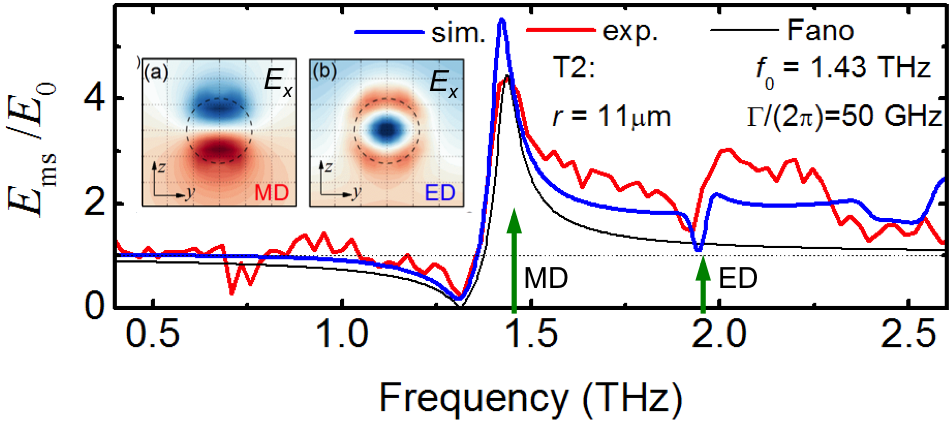 |
|
|
University College London - Gower Street - London - WC1E 6BT - ![]() +44 (0)20 7679 2000 - Copyright © 1999-2014 UCL
+44 (0)20 7679 2000 - Copyright © 1999-2014 UCL